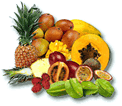
January 2006
The Daley News
Some beautiful rain has kick-started the year for us here in Kyogle. It is being lapped up by us all and is hopefully a good sign for the year to come. In the orchard the acerola cherry is covered with fruit, although I don’t expect these to last for long as they are a favourite with the team here. For those of you not familiar with the acerola it has small bright red fruits that are very high in vitamin C. While they are not super sweet, their juicy flesh has a delightful tang about it. My personal favourite the Panama Berry is fruiting and the fruits on my tree at home are the biggest, fattest, sweetest Panama berries I have ever seen and tasted. They have really enjoyed the rain. 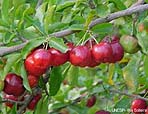 We are also relishing the grapes and the last of the mango's. Now is a perfect time to be planting fruit trees, with high moisture levels in the soil and still a long growing season before the soil cools down small trees have plenty of time to establish themselves. We have some beautiful rainforest trees and a small selection of grafted fruit trees in 35 litre bags for those who are interested in landscaping plants. They are a bargain at only $69 but they will have to be collected from us here at the nursery.
We are also relishing the grapes and the last of the mango's. Now is a perfect time to be planting fruit trees, with high moisture levels in the soil and still a long growing season before the soil cools down small trees have plenty of time to establish themselves. We have some beautiful rainforest trees and a small selection of grafted fruit trees in 35 litre bags for those who are interested in landscaping plants. They are a bargain at only $69 but they will have to be collected from us here at the nursery.
Fruit Fly Control
The 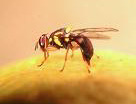 Fruit fly is one of the most frustrating and disappointing challenges about growing fruit in the backyard. What looks at first to be a perfect ripe piece of fruit, on closer inspection has the tell tale sting mark and is already decomposing and writhing with maggots. There is nothing more disappointing. Personally I have always preferred a few maggots to fruit that has been sprayed with an unhealthy cocktail of chemicals but this attitude does not help the fruit growers who have to tackle with the flies to make a living. The cost to Australian agriculture in lost produce to fruit fly attack is around the one hundred million dollar mark annually. It is the responsibility of all home fruit growers to control fruit fly in their orchards. A simple measure is to pick up all fallen fruits and destroy them - this is essential to the health of any orchard. The female fly lays her eggs in maturing fruit, as these infected fruits fall to the ground the larvae then burrow into the ground and emerge as adult fly to continue the cycle. Picking up fallen fruits, reduces the numbers of larvae in the ground under fruit trees, but does not eliminate fruit fly.
Fruit fly is one of the most frustrating and disappointing challenges about growing fruit in the backyard. What looks at first to be a perfect ripe piece of fruit, on closer inspection has the tell tale sting mark and is already decomposing and writhing with maggots. There is nothing more disappointing. Personally I have always preferred a few maggots to fruit that has been sprayed with an unhealthy cocktail of chemicals but this attitude does not help the fruit growers who have to tackle with the flies to make a living. The cost to Australian agriculture in lost produce to fruit fly attack is around the one hundred million dollar mark annually. It is the responsibility of all home fruit growers to control fruit fly in their orchards. A simple measure is to pick up all fallen fruits and destroy them - this is essential to the health of any orchard. The female fly lays her eggs in maturing fruit, as these infected fruits fall to the ground the larvae then burrow into the ground and emerge as adult fly to continue the cycle. Picking up fallen fruits, reduces the numbers of larvae in the ground under fruit trees, but does not eliminate fruit fly. 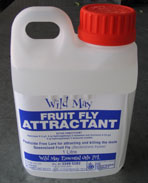
This year at Daley's we have began a trial of a new and certified organic product for the control of fruit fly called Wild May. We look forward to bringing you the results of this trial that will be undertaken for a minimum of 12-24 months. We have a mixed orchard with 200 fruit trees in an area of ½ a hectare, in this space we have set two traps that are monitored on a weekly basis.
Wild May is a male attractant; it works by attracting and killing all the male flies including juveniles before they can breed. Wild May is BFA registered so it is a product suitable for use by all organic producers. It will not harm other insects and beneficial bugs.
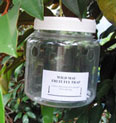 Wild May can be used in conjunction with other organic products, including exclusion bags. These are available from Green Harvest at www.greenharvest.com.au. They are a very economical way of protecting fruits that are within reach on any tree. Daleys Nursery worker, Tara, was telling me about the huge peaches that she cropped last spring with the use of these bags. They had no fly in them and they have the added advantage of protecting fruits from the birds.
Wild May can be used in conjunction with other organic products, including exclusion bags. These are available from Green Harvest at www.greenharvest.com.au. They are a very economical way of protecting fruits that are within reach on any tree. Daleys Nursery worker, Tara, was telling me about the huge peaches that she cropped last spring with the use of these bags. They had no fly in them and they have the added advantage of protecting fruits from the birds.
Wild May can also be used with another new and exciting certified organic product called Naturalure. This female baiting product is sprayed on susceptible trees to attract and kill the female fly. Trees need to be sprayed on a regular basis for this to be successful. When using in conjunction with Wild May it is easy to see when the flies are at their most active and spray accordingly.
Drumstick or Horseradish Tree – Moringa oleifera
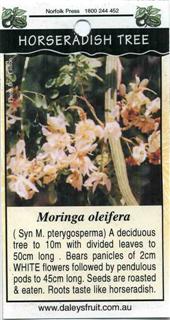 This is the most amazing trees that we sell. Originating from India it is an attractive fast growing tree with delicate foliage and pale yellow flowers. All parts of the tree are edible and many have other amazing uses and properties. The long green pods taste similar to asparagus, the leaves make a highly nutritious vegetable and the protein rich roots are used as a substitute for horseradish. It is also an ideal shade tree and is very drought resistant. The quality that I find the most astounding is its ability to purify water. The seeds of the drumstick are able to drag contaminates in a water container to the bottom and ensure that the mud does not rise again in the same way that aluminum sulfate does. In order to do this the seeds need to be crushed and pulverized with a pestle and mortar until they are reduced to a dust. To cleanse the water the pulverized seeds are mixed into the dirty water. The cleansing results from the electrical charges that are established between the muddy particles and the pulverized particles of the Moringa seeds. The electrical currents gather the suspended particles around the seed particles resulting in larger and heavier particles of impurity that sink to the bottom of the container leaving clean water on the top. The Moringa does not remove all pathogenic impurities but it does make dirty water clean, and drastically reduces the quantity of microorganisms. This process does not alter the taste of the water.
This is the most amazing trees that we sell. Originating from India it is an attractive fast growing tree with delicate foliage and pale yellow flowers. All parts of the tree are edible and many have other amazing uses and properties. The long green pods taste similar to asparagus, the leaves make a highly nutritious vegetable and the protein rich roots are used as a substitute for horseradish. It is also an ideal shade tree and is very drought resistant. The quality that I find the most astounding is its ability to purify water. The seeds of the drumstick are able to drag contaminates in a water container to the bottom and ensure that the mud does not rise again in the same way that aluminum sulfate does. In order to do this the seeds need to be crushed and pulverized with a pestle and mortar until they are reduced to a dust. To cleanse the water the pulverized seeds are mixed into the dirty water. The cleansing results from the electrical charges that are established between the muddy particles and the pulverized particles of the Moringa seeds. The electrical currents gather the suspended particles around the seed particles resulting in larger and heavier particles of impurity that sink to the bottom of the container leaving clean water on the top. The Moringa does not remove all pathogenic impurities but it does make dirty water clean, and drastically reduces the quantity of microorganisms. This process does not alter the taste of the water.
The oil that is produced from the seeds of the Moringa is another very useful product from this plant. It is sweet, clear, and odorless and does not become rancid. Consequently it is edible and used in the preparation of perfumes and hair products as well as its use in manufacturing where it is used as a lubricant. The foliage is used as a fodder plant for cattle, sheep, goats, pigs, rabbits and can be used to feed carp and other fish. The wood yields a blue dye and the bark is used to make rope and other fibers. All parts of the Moringa have been widely used in traditional medicine to treat many ailments. India's ancient tradition of ayurveda says the leaves of the Moringa tree prevent 300 diseases. The leaves contain four times the amount of calcium as milk as well as twice the protein. Seven times the amount of vitamin C in an orange, three times the potassium contained in bananas and four times the vitamin A in carrots. It truly is an amazing tree.
References.
http://www.moringatrees.org/index.html
http://www.hort.purdue.edu/newcrop/duke_energy/Moringa_oleifera.html
If a Tree Was a Saint – By Raquel Fernandez
Finger Lime - Citrus australasica
 The native Australian finger lime has truly come into flavour in the past few years with recognition from international chefs. Endemic to the rainforests of Northern NSW and Southern Queensland, the finger lime is a very prickly understory plant that grows 1-6 m. It naturally occurs in vine thickets and drier rainforests of this region and is often unseen among all the other prickly varieties of plants in this forest type. The fruits are wonderful, they are
The native Australian finger lime has truly come into flavour in the past few years with recognition from international chefs. Endemic to the rainforests of Northern NSW and Southern Queensland, the finger lime is a very prickly understory plant that grows 1-6 m. It naturally occurs in vine thickets and drier rainforests of this region and is often unseen among all the other prickly varieties of plants in this forest type. The fruits are wonderful, they are 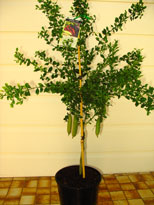 long, cylindrical limes that range in skin colour from black, purple, red and green through to yellow with interesting combinations of colour on the inside, including red, pink, and lime green, although many have clear flesh and juice. The inside of the fruit consists of many globular vesicles containing the lime-flavoured juice with a small amount of seed. When the fruits are cut in half and squeezed lightly, individual balls of limejuice bubble out of the skin. They are wonderful to use as a garnish for savoury dishes and hourderves. Fruits can be enjoyed fresh out of the hand unlike other limes, which for most of us are too tart; the native lime is delicious and not as acidic or sour as other limes and lemons to which they are closely related.
long, cylindrical limes that range in skin colour from black, purple, red and green through to yellow with interesting combinations of colour on the inside, including red, pink, and lime green, although many have clear flesh and juice. The inside of the fruit consists of many globular vesicles containing the lime-flavoured juice with a small amount of seed. When the fruits are cut in half and squeezed lightly, individual balls of limejuice bubble out of the skin. They are wonderful to use as a garnish for savoury dishes and hourderves. Fruits can be enjoyed fresh out of the hand unlike other limes, which for most of us are too tart; the native lime is delicious and not as acidic or sour as other limes and lemons to which they are closely related.
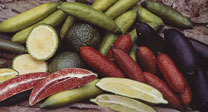 The finger lime is a fantastic regeneration tree as it attracts small birds to the safety of its thorns and is the host plant for the native large citrus butterfly, Papilio aegeus, also known as the orchard swallowtail. For this purpose, it is best to plant seedling or cutting grown trees so there is no rootstock plants involved.
The finger lime is a fantastic regeneration tree as it attracts small birds to the safety of its thorns and is the host plant for the native large citrus butterfly, Papilio aegeus, also known as the orchard swallowtail. For this purpose, it is best to plant seedling or cutting grown trees so there is no rootstock plants involved.
Blue Quandong - Elaeocarpus grandis
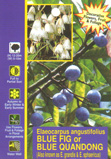 The blue quandong is a beautiful buttressed fast growing rainforest tree native to Eastern Australia from the mid-north coast of NSW to far-north Queensland. It is an excellent pioneer tree and a great tree to grow in woodlots for its highly regarded pale timber. Mature trees can reach heights of 40m and have an attractive open crown that allows light to penetrate below, making it an ideal tree for establishing rainforest plants underneath. The foliage is very attractive with a scattering of vivid scarlet leaves that show off amongst the green foliage before they drop. The bright blue fruits contrast against these red leaves and are highly sought after by rainforest pigeons. The thin layer of green flesh around the seed is edible but is rather sour to insipid in flavour. Textured like a brain the ornamental seeds can be used for jewelry and ornamentation. The flowers of the blue quandong are small but beautiful, bell-shaped and greenish-white in colour. Trees flower from March – June and the fruits form in spring.
The blue quandong is a beautiful buttressed fast growing rainforest tree native to Eastern Australia from the mid-north coast of NSW to far-north Queensland. It is an excellent pioneer tree and a great tree to grow in woodlots for its highly regarded pale timber. Mature trees can reach heights of 40m and have an attractive open crown that allows light to penetrate below, making it an ideal tree for establishing rainforest plants underneath. The foliage is very attractive with a scattering of vivid scarlet leaves that show off amongst the green foliage before they drop. The bright blue fruits contrast against these red leaves and are highly sought after by rainforest pigeons. The thin layer of green flesh around the seed is edible but is rather sour to insipid in flavour. Textured like a brain the ornamental seeds can be used for jewelry and ornamentation. The flowers of the blue quandong are small but beautiful, bell-shaped and greenish-white in colour. Trees flower from March – June and the fruits form in spring.





